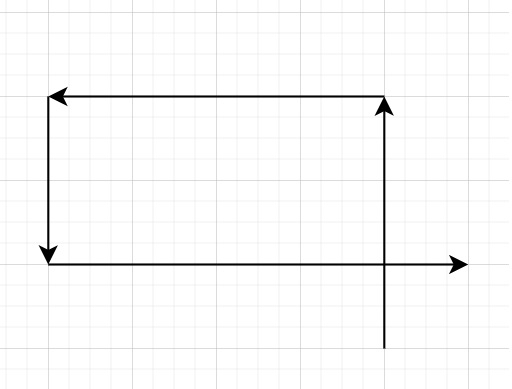
 Data Structure
Data Structure Networking
Networking RDBMS
RDBMS Operating System
Operating System Java
Java MS Excel
MS Excel iOS
iOS HTML
HTML CSS
CSS Android
Android Python
Python C Programming
C Programming C++
C++ C#
C# MongoDB
MongoDB MySQL
MySQL Javascript
Javascript PHP
PHP
- Selected Reading
- UPSC IAS Exams Notes
- Developer's Best Practices
- Questions and Answers
- Effective Resume Writing
- HR Interview Questions
- Computer Glossary
- Who is Who
Self Crossing in C++
Suppose we have an array x of n numbers. We start at point (0,0) and moves x[0] units to the north direction, then x[1] units to the west direction, x[2] units to the south direction , x[3] units to the east direction and so on. In other words, after each move our direction changes counter-clockwise. We have to devise an one-pass algorithm with O(1) extra space to determine whether our path crosses itself, or not.
So if the array is like − [3,4,2,5]

Answer will be true.
To solve this, we will follow these steps −
insert 0 at the index 4 of x
n := size of x, i := 4
-
for not initializing anything when i < n and x[i] > x[i - 2], increase i by 1 do −
Do nothing
if i is same as n, then, return false
-
if x[i] >= x[i - 2] - x[i - 4], then,
x[i - 1] = x[i - 1] - x[i - 3]
-
for increase i by 1, when i < n and x[i] < x[i - 2], increase i by 1 do −
Do nothing
return true when i is not same as n
Example
Let us see the following implementation to get better understanding −
#include <bits/stdc++.h>
using namespace std;
class Solution {
public:
bool isSelfCrossing(vector<int>& x) {
x.insert(x.begin(), 4, 0);
int n = x.size();
int i = 4;
for(; i < n && x[i] > x[ i - 2];i++);
if(i == n) return false;
if (x[i] >= x[i - 2] - x[i - 4]){
x[i - 1] -= x[i - 3];
}
for (i++; i < n && x[i] < x[i - 2]; i++);
return i != n;
}
};
main(){
Solution ob;
vector<int> v = {3,4,2,5};
cout << (ob.isSelfCrossing(v));
}
Input
{3,4,2,5}
Output
1

